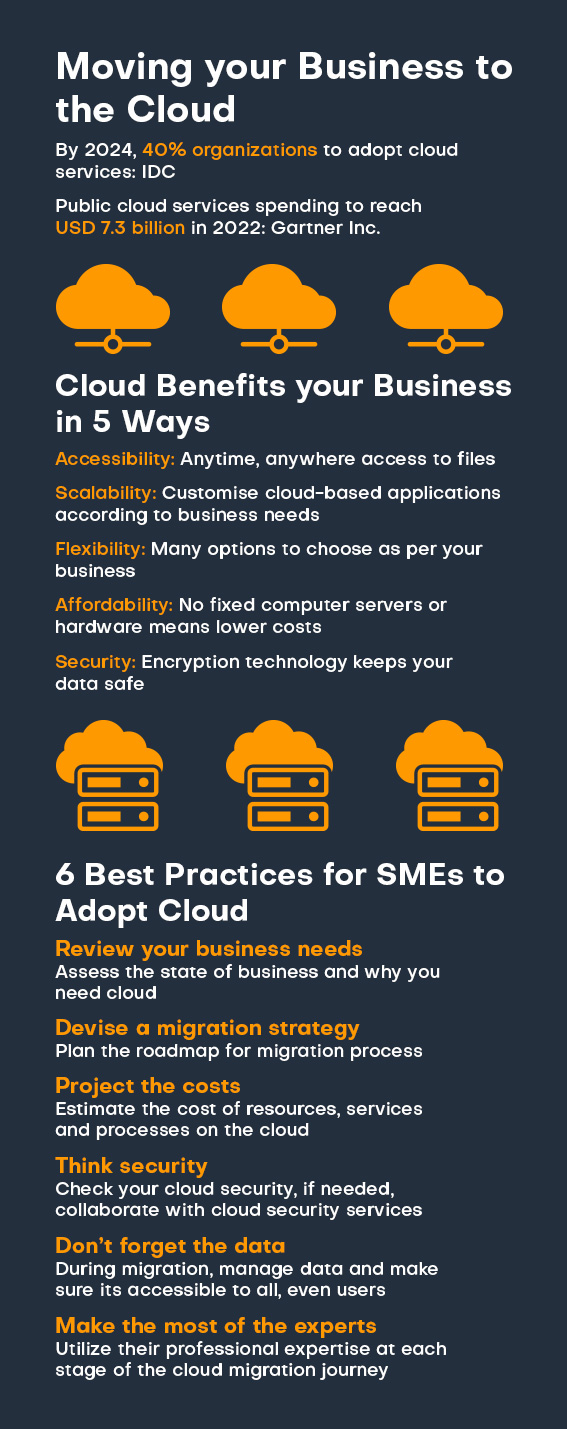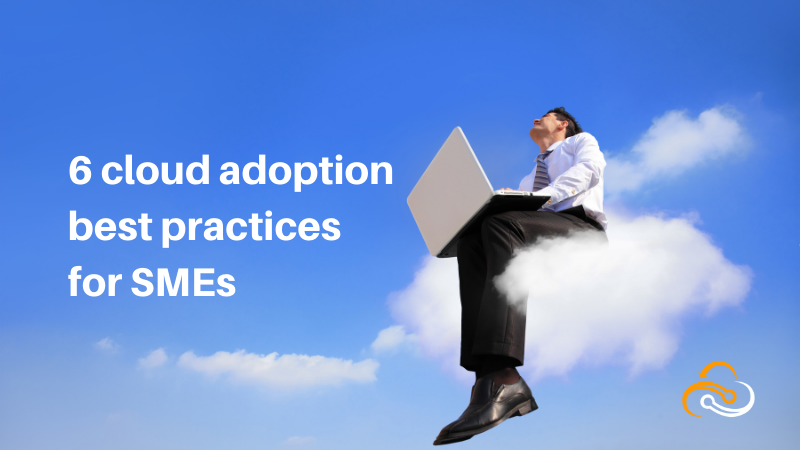The future belongs to intelligent organizations. This sentence hints at what SMEs should be doing now—shifting from a ‘process-driven’ mindset to a ‘data-driven’ culture. This is where cloud services come in.
Companies must accelerate their journey into the cloud in a post-pandemic world, which is defined by a high demand for remote work, e-commerce, and virtual learning, among other fundamental shifts in consumer demand.
With this, there has been a widespread acceptance of the promise that the cloud brings. In fact, the cloud has risen to the top of the C-suite agenda as small and medium enterprises shift from a piece-meal approach to a more holistic digital transformation.
According to International Data Corporation (IDC), by 2024, 40% of organizations will implement dedicated cloud services either on-premises or in a service provider facility in response to the performance, security, and compliance requirements.
Furthermore, Indian enterprises are considering a hybrid solution that combines solutions from public cloud service providers and traditional infrastructure software or equipment providers to gain the benefits of a private cloud’s security and control as well as the elasticity of a public cloud. In addition, factors such as the ongoing pervasive disruption, digital-first approaches, the digital ecosystem, and others could drive cloud adoption among Indian organizations.
Cloud migration, on the other hand, is a complex, time-consuming, and resource-intensive exercise that is simple to understand but can be daunting for small and medium businesses to implement. To adopt cloud, SMEs need to develop a migration strategy that can assist them to fully understand the expectations and benefits thereof.
Understanding the needs
End-user spending on public cloud services in India is expected to reach $7.3 billion in 2022, up 29.6 percent from 2021, according to Gartner Inc.
Given this scenario, cloud adoption in Indian organizations continues to rise.
However, before deciding on a cloud service provider, businesses must first understand why they require cloud services. Also, they should make a list of their expected benefits from cloud adoption. For instance, a few key goals to achieve from cloud solutions are—
- Achieving the efficiency and resilience of IT systems
- Accomplishing new things and doing them faster
- Achieving leaner and more agile operations
While there are multiple advances that companies can gain from the cloud, that doesn’t imply that it will fit your needs. Sometimes, adopting cloud may necessitate changes throughout your organization. Recognizing the need depends on the business requirements i.e., storing data on the public cloud, making your processes easier, app designing, and so on.
Simply put, understanding how moving to the cloud will help you achieve your business goals.
Devise a migration strategy
Cloud migration is the process of transferring digital processes (data and applications) to cloud servers. And to plan this transition, SMEs need to develop a cloud migration strategy. A well-planned migration strategy can help with faster implementation, mobility, scalability, increased effectiveness, business agility, and disaster recovery with fewer risks.
A successful cloud migration strategy is based on the organization’s current needs as well as what it will require in the future. This roadmap should also take into account their day-to-day operations, their company size, the complexity of their IT infrastructure, and the number of tools and platforms that are used in their operations.
The basic steps of cloud migration processes are frequently the same, but they differ for each organization. Simultaneously, it makes sense to start the cloud journey with the cloud-as-a-service (CaaS) option, as it can provide a customizable solution to drive their growth.

Project the costs
Adopting cloud computing is more of an economic decision for SMEs than a technical one. Before migrating to the cloud, SMEs should consider whether the public cloud is a good fit for their needs. Experts advise carefully considering and comparing the various cloud solutions that are available.
Additionally, SMEs can estimate the cost of storing their resources and operating their processes in the cloud and determine whether replacing legacy solutions can save them money. They should consider the cost of the licenses and the regulatory requirements too as these options will vary depending on a company’s specific business circumstances.
Also, SMEs can plan their strategies based on the number of their employees who will require access, as the software is sold on a per-user basis. Furthermore, they should double-check for any hidden conditions or costs.
Before you transfer everything, reskill your team on the latest processes and train them in the cloud environment. Often business users too may need to adapt to the new systems and services available to them in the cloud.
Think security
Companies often deal with sensitive information. Furthermore, as digital transformation has accelerated, data breaches have become more common. Given this, cloud service providers bundle necessary security features into their solutions. However, having additional layers of cybersecurity in place once a business moves to the cloud is okay.
The correct course of action is to assess your cloud security strength. Another critical strategy is to involve your security team from the beginning of the cloud migration process. If this is not possible, then SMEs can collaborate with cloud security services to develop robust cloud security. This step further promotes the growth of SMEs by securing critical data.
Don’t forget the data
Businesses keen to shift to the cloud, often hastily try to move workloads or apps (data) to the cloud in one go, owing to the cost involved. This move can go wrong. It’s best to start slow and automate your processes as per the priority.
At the same time, it’s also critical to think about each business’s applications and their users’ accessibility during the shifting process. According to Accenture analysts, to shift data to the cloud, businesses must:
- Ensure that the data is accessible to all users.
- Implement data management to check that the data is reliable, high-quality, traceable, and trusted by the business.
- Create an enterprise data governance program to ensure that the business owns the data and can properly leverage it.
Migration cannot be an IT-only exercise. The majority of cloud migration pitfalls occur when IT and the business are not on the same page. So, keep your eyes on that too!
Make the most of the experts
Finding the right partner(s) is critical to ensuring that your cloud migration journeys are flawlessly designed, prioritized, executed, and evolved. Cloud adoption or migration, on the other hand, can be difficult for small and medium-sized businesses, necessitating the handheld assistance of cloud experts.
For them, collaborating with the right partner can be a game-changer. As a result, SMEs should make the most of their chosen cloud service provider. They should utilize their professional expertise at each stage of the cloud migration journey to ensure a smooth delivery process and to resolve any challenges.
Finally, stick to the plan and keep an eye on the business requirements and the risks while adhering to the security policies. Also, to avoid the pitfalls, perform a test migration first.
Final thoughts
The pandemic was a watershed moment for Indian businesses to recognize the importance of migrating to cloud infrastructure, which accelerated the adoption of cloud services within the SME ecosystem. Furthermore, the government’s push for cloud policy infrastructure, such as its Meghraj and Cloud Vision for 2022 announcements, is contributing to the growth of the public cloud. These will be useful for small and medium-sized businesses, as well as for those companies in the early stages of cloud adoption, allowing them to greatly benefit from this technology.


